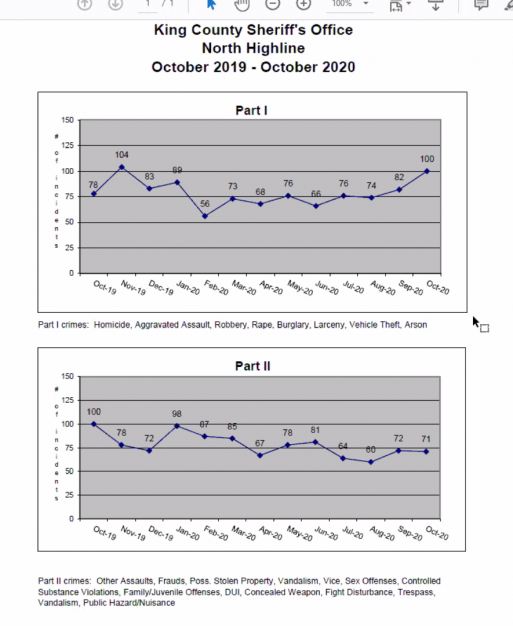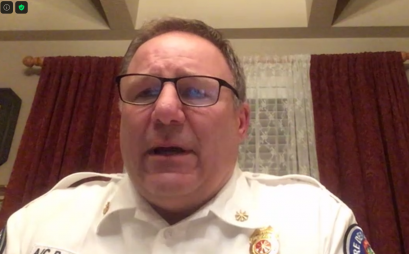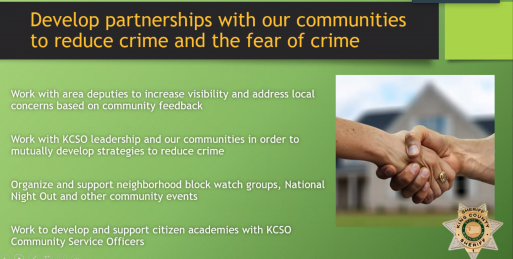By Tracy Record
White Center Now editor>
Three hot topics comprised this month’s North Highline Unincorporated Area Council meeting, first one of 2020.

OPEN SPACE: Sarah Brandt from King County Parks leads this program and tackled several topics, starting with the Land Conservation Initiative.
The county’s been accelerating protection of habitat and acquisitions in the past couple years. While several different types of open space are covered, she primarily spoke about urban greenspace. To make greenspace more equitable in urban areas, they used several criteria to identify areas where it’s most needed – including parts of White Center. The Parks Levy provides up to $10 million a year for acquisition, and there’s a tax that can be used too.
What’s in the potential pipeline includes:
-White Center Heights Park – a house nested in the park was purchased and will be demolished (on 8th just north of 106th)
-Forested 5-acre parcel toward the east (8th S., 101 to 103) – they’re in negotiations for this
-Looking at opportunities to grow Dick Thurnau Park
-Looking at an area south of Roxbury
“We’re doing more and want to hear more from the community …it can be a pocket park, a trail connection ..” She opened the floor. NHUAC president Liz Giba suggested that the current WC Food Bank site would be better used as open space (currently it’s slated for mixed-use development).
What about an area near Grace Church? someone asked. Discussions are under way, in fact.
Another suggestion: Consider the health impacts when you remove trees. Concerns were voiced about the removal of street trees. And another: Take into consideration residential development and how kids living there will get to parks.
Question: Once the county buys the land, what happens? Answer: Thy’re trying to cultivate partnerships. Washington Trails Association is one such organization. Grant programs can help with that. “We’re trying to help people understand how to fit together these funding sources.”
Question: What about the big open area near The Bog? Answer: Parks will endeavor to work more closely with Natural Resources.
There was also some discussion of what would happen to open-space-designated areas if North Highline were annexed. It was pointed out that the city zoning code is more complicated than the county’s, and in an annexation the annexing city might try to match its closest comparable zoning with what’s there now.
Another suggestion, when the subject of currently vacant land came up, 1st and 112nd.
Next topic – trees. A new climate-action plan is due out before year’s end. The county is close to its promise of planting 1 million new trees, she declared. By the end of this year, they hope to have a 30-year plan/vision. They want to remove barriers for people working to enhance that. “Our business district has one tree,” pointed out NHUAC vice president Barbara Dobkin. “Vocal advocacy” was advised by Brandt.
Some other concerns were voiced, including unstable trees and how to deal with them – before and after something disastrous happens. That spun off into a discussion of replacement policies – in King County and some of its cities. Hugo Garcia from the county said he’d look into what the policy is when government crews have to remove a tree.
Big question: Is access to greenspaces – like sidewalks – part of the plan? “Tell us that’s important,” urged Brandt. A discussion ensued of sidewalk challenges like this swamped section on the south side of Roxbury between 12th and 14th (photo courtesy Gill Loring):

NORTH HIGHLINE SUBAREA PLAN: David Goodman brought an update on the taking-shape plan, first one since October. He’s talked to “all sorts of people” in recent months, including schools, businesses, and “came up with this general proposal.” (Get a closer, clearer look via the PDF on the Subarea Plan website.)

The residential-zonng overview: “Housing affordability was a big theme,” he began. So they’re “slightly increasing the allowed density” near the 16th Ave. corridor. Where there’s one house now, there could be two units. They tried to focus on areas close to a commercial core and/or near a bus line. A zoming change, he stressed, wouldn’t mean you HAVE TO make a change if you didn’t want to. Greenbridge isn’t included “because it’s already at a higher density than we’re proposing.”
There’s a “P” designation – where you see that, the dimensions wiil be restricted to what they are now.
One person asked about Accessory Dwelling Units – they can be up to 1000 square feet. They would drop the current rule for one to be awner-occupied. (UPDATE: Goodman later clarified with the following:
The requirement that when a property has both a primary dwelling unit (a regular house) and an accessory dwelling unit (allowed to be up to 1000 square feet in size) one of them must be owner-occupied will stay the same. The difference under our proposed zoning for particular neighborhoods is that you could have two primary units (such as in a duplex or a townhouse-style development) in many cases where you are currently only allowed one; in this case, with two primary units, neither has to be owner-occupied because neither is an accessory dwelling unit.
In both of these cases you have two units on the property; the difference is that in the first case one is a primary and one is an accessory, and in the second case both are primary. In practice there is minimal difference between these two situations, but the regulations for owner-occupation kick in only when one of the units is considered accessory.
Regarding sidewalks – they would be required with increased density, Goodman noted. He also addressed the proposals for commercial areas – first, expanding the pedestrian area, so future new construction would be “less car-oriented.”

Two parcels that are east of 15th and south of 100th and that are currently industrial would be changed to commercial and mixed-use – retail ground floor, apartments over it, mindful of the fact that RapidRide H Line will be running on 15th SW. They would be required to be 20 percent housing that’s “affordable.” Meantime, in the heart of downtown White Center (along 16th), they do NOT plan to go higher-rise – “mostly at the scale it currently is,” limited to three stories.
Who would be trying to attract new investment/development? Prospective buyers/developers could work with Garcia’s Economic Development department, he said.
What about parking? King County still has requirements for that, Goodman said.
Seguing to Top Hat, Goodman pointed out that the last plan for this area was written in 1994. Unlike WC, Top Hat would allow some industrial uses – “small manufacturing,” for example. What’s zoned commercial now will remain that way, but certain small industrial uses will be allowed – a special “additional allowance,” if you will.

Garcia said they’re hoping that over time more such things – a small firm making dog accessories was mentioned multiple times – will move in.
He also said the King County Conservation Corps is moving further into WC and they hope to expand it to Top Hat. And Garcia urged people to get more deeply involved in the plan because there’s still time to have a say before this goes to the County Council.
As mentioned in our coverage of last week’s open house, what’s ahead in the Subarea Plan process includes:
-Public draft plan mid-March to mid-April
-Official draft to County Council in June (there’ll be commenting opportunities while they consider it too)
The county reps were invited to return in April to talk about other things such as the Opportunity Zone and the Hub project (on the WCFB site).
KING COUNTY SHERIFF’S OFFICE: Deputy Bill Kennamer first offered praise for Local Services, saying “it’s kicked butt” in improving downtown White Center.
Crime stats are “pretty even year to year” – auto theft’s still high, burglary is down.
Problem properties: Two of the worst are moving well along, the deputy said – code enforcer Nick Stevens has been working on a house whose owners are a “large property management company” that just got a $12,000 fine and is suddenly up for sale, not far from Holy Family. Then there’s a “drug house” near 98th/13th; its owner died without a will, a family member moved in and allowed people to stay there in exchange for drugs – with no water service. It was in horrible condition, Kennamer said. But the probate’s since been settled; it’s expected to be sold, and the problem relative has been arrested three times. A cleanup crew’s been there and it’s been sealed with plywood. Regarding another one, near 1st/106th – they’ve spoken with the landlord and the problem tenant’s out, with the house being remodeled.
A variety of other quick questions were addressed. Deputy Kennamer noted the past month included about half a dozen firearms-involved crimes with people who shouldn’t have had guns. Earlier Thursday, he added, they were chasing a suspect wanted on warrants.
Kennamer also mentioned that LEAD (Law Enforcement Assisted Diversion) is on the way to White Center.
NEXT MEETING: If you care what’s going on in your community – be there in person next time! 7 pm March 5th, North Highline Fire District HQ (1243 SW 112th). Options for White Center youth will be discussed.































